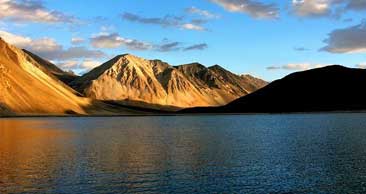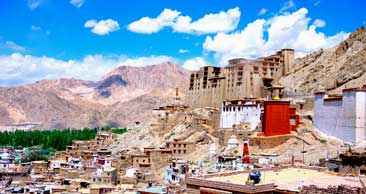

Ladakh has a rich heritage of folk dance. The dances are elaborate, colourful, and majestic, with mostly slow and gentle movements matched by the richly adorned peraks (head dress), and music.
Among the folk dances are –
The Jabro Dance of the Changthang people performed during festive occasions. It is an integral part of Losar (Tibetan New Year), and the Jabro songs are sung to the accompaniment of the Damian, a guitar-like instrument, and the flute.
The Tukhstanmo dance of Zanskar and Bakhamul area.
The Spao dance, which is a warrior dance associated with the legendary figure Gesar.
The Loshon Dance performed on the eve of the harvest festival at Shey village.
The Shoudol dance, the only dance that involves backward steps.
The Mentoq Stanmo dance, a flower dance and recitation of songs, of Deskit and Dha Hanu.
The Shon dance, a legacy of the royalty of Ladakh. Originally a dance presented in honour of the kings of Ladakh, now without restriction.
The Koshan dance of Leh, which is preceded by a horse race.
One of the most important aspects of Ladakhi culture is the rich oral literature of
songs and poems for each occasion.
The religious dance performed by the lamas (monks) is called Chhams and is related to monastic festivals, where it is performed to the music of the Monastic orchestra. Each monastery has its own orchestra. The dancers wear elaborate masks ranging from the fearsome and grotesque to the pleasing, and fine silk costumes representing various divinities from the Buddhist pantheon. Chhams are not meant for amusement but are spiritual, invoking blessings in order to wars off evil.
The music accompanying the Chhams is generally slow and haunting, and the musical instruments involved are the Dungchen (long horn), Gyaling (oboe), Nga (drums), Silnyen/bubjal (cymbals), kangling (shinbone trumpets), dung (conch shells), Damaru (skull drums) and Drilbu (bells). The masked dancers move around very slowly; the vital part of the dance being the mask, not the dance. All dances end with good triumphing over evil. The dances are performed not only to symbolize destruction of evil but as offerings to the monastery deity.

Best of Leh - Kashmir
Duration : 17 N / 18 D
Routing : Srinagar - Gulmarg - Pahalgam - Sonmarg

Best of Leh - Manali
Duration : 18 N / 19 D
Routing : Amritsar - Dharamshala - Manali - Sarchu

Glimpses of Leh - Ladakh
Duration : 9 N / 10 D
Routing : Leh - Lamayuru - Alchi – Likir

High Altitude Lake Tour
Duration : 9 N / 10 D
Routing : Leh - Uleytokpo - Pangong Lake

Kerala with Ladakh
Duration : 20 N / 21 D
Routing : Cochin - Munnar - Periyar - Kumarakom

Ladakh Cultural Tour
Duration : 8 N / 9 D
Routing : Leh Monasteries - Lamayuru - Alchi

Ladakh with Golden Triangle
Duration : 17 N / 18 D
Routing : Delhi - Jaipur - Agra - Delhi – Leh - Lamayuru

Ladakh - Kashmir Tour
Duration : 11 N / 12 D
Routing : Delhi - Leh - Pangong Lake - Leh - Alchi

Ladakh with Classical India
Duration : 21 N / 22 D
Routing : Delhi - Jaipur - Agra - Jhansi - Khajuraho

Ladakh with Taj
Duration : 16 N / 17 D
Routing : Delhi - Agra - Leh Monasteries - Lamayuru